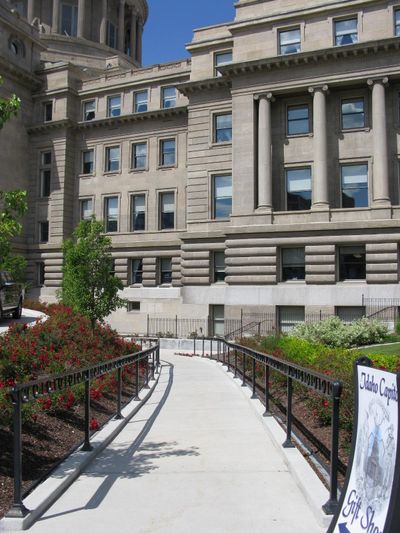Idaho to spend $400K to bring renovated Capitol into compliance with ADA

BOISE – Five years after completing a three-year, $120 million renovation of its state capitol, Idaho is preparing to spend another $400,000 to bring the building into compliance with the Americans with Disabilities Act – after state officials wrongly assumed the historic structure was exempt.
“We were operating under the premise that we were not fully reconstructing the capitol building,” Jan Frew, state deputy public works administrator, told lawmakers last week. “It’s a historic building, so we were utilizing many of the exemptions that are allowed for historic buildings.” Those included, for example, making all programs in the building accessible, but not all doors and entrances.
But the U.S. Department of Justice received a complaint that the building renovation didn’t meet the law’s requirements, and after an extensive investigation, negotiated 110 changes with state officials. Receiving a complaint, Frew said, “triggers them to come out and look at absolutely everything.”
The work will start this summer and be completed by July of 2017; it includes everything from adding wheelchair-accessible seating to the House and Senate galleries, to installing signage throughout the building that includes Braille, to pouring new concrete ramps.
“When the Department of Justice became involved, their main interpretation was that if you’re spending $120 million, whether it’s new or existing, every part of the capitol building should be accessible,” Frew said. “They didn’t think that the historic building exceptions should apply any more.”
She said, “We have gone back and forth on a number of issues. They have made some concessions, a few. And we, of course, want to make the building as accessible as possible. So we have come to a compromise.”
That compromise includes removing some VIP seating from the House and Senate galleries to make room for the wheelchair-accessible spots, which means moving a partial wall and relocating the big monitor of House votes so that it’ll be suspended from the ceiling; crafting new door pulls or levers that are accessible, but are made to mimic the historic doorknobs they’ll replace; adding signs to direct people more easily to accessible routes, including accessible elevators; and altering the east and west first-floor entrances to the capitol to include accessible ramps, rather than the current three steps up.
But perhaps the most controversial requirement is that Idaho tear out and replace two curved, sloping sidewalks that lead down to the new accessible, lower-level south entrance that was added in the renovation – because they were found to be a half-percent off from cross-slope requirements.
Idaho Lt. Gov. Brad Little, who serves on the state Capitol Commission, said, “It was really frustrating to have to spend this much money, and I know the capitol is so much more accessible than it used to be.” The renovation included adding underground wings with large new public hearing rooms, additional elevators and more.
But Little said, “I guess we’ve got to do what we’ve got to do. … We want to make darn sure that we’re OK.”
The cross-slope for the ramps is allowed to be at a maximum of 2 percent, but when federal officials inspected, they found it measured 2.5 percent. “The design showed it as the 2 percent, and it has not settled,” Frew said. “It was basically put in incorrectly. However, we accepted it, and the time for requiring the contractors to come back in is long past.”
In fact, the state had previously required contractors to tear out and re-do those same sections of sloping, curving sidewalk. “In good conscience, since we accepted their work, we didn’t feel like we could go back to them and say, ‘Oh, by the way,’” Frew said.
Replacing just those sloping sidewalks and their handrails will cost about $50,000, Frew estimated.
“Oh my goodness,” responded Senate Majority Leader Bart Davis, R-Idaho Falls.
Rep. Phylis King, D-Boise, asked Frew if there was “any way to appeal.” Frew responded that the state’s options were to work with the Department of Justice, or the department would take the state to court, “and spend years fighting about what we could fix for about $400,000.”
Funding for the modifications will come from state endowment funds that are dedicated to maintenance of the state capitol.
Other modifications in the works include adding wheelchair-accessible seating in the Lincoln Auditorium, the new large public hearing room that was added in the renovation. More minor changes include adjusting door-opening mechanisms and moving furniture that blocks accessibility.
A list of all 110 modifications, obtained under the Idaho Public Records Act, shows an estimated total cost of $388,075.
Lt. Gov. Little, who presides over the state Senate when it’s in session and formerly served there for four terms, said, “All said and done, (given) the fact that we did that marvelous remodel on time and on budget, $400,000 is kind of a rounding error on a $120 million project.”
He added, “We are really lucky in Idaho. … We’re so blessed to have a working capitol, and it’s really a working capitol.”